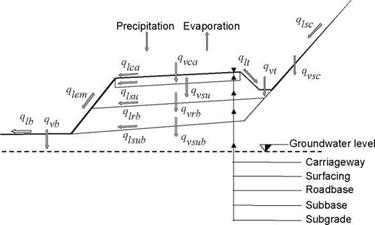Water Balance
For a better understanding of the qualitative and quantitative relationships between water and roads, the general interaction of road to water should first be established. The approach adopted here for this interaction analysis is by considering the water balance.
The relation between a road and water can be defined in system theory terms where input and output values are observed. Thus, the road and its pavement can be defined as a system into and out of which water flows. In normal conditions the input to the road pavement is represented by precipitation. Rainfall, or water due to thawing, infiltrates the pavement and flows through into the surrounding environment. Reverse flow of surface or groundwater towards the pavement embankment is also possible.
The general water balance equation can be simply defined as
P = R – ETR + IR (2.1)
or
P = R – ETR + G + AS (2.2)
each term having units of volume/time/area [L/T] and where P represents the precipitation, R is the surface runoff, ETR represents evapotranspiration, G is the deep percolation or the groundwater recharge, IR is the surface infiltration and AS is the water storage change (or the net volume flux, thus qout – qin) of the pavement structure or the embankment. When some external inflow, qext, to the system is present, the water balance equation is defined as
P + qext = R – ETR + G + AS (2.3)
The presence of external flow qext is particularly important when we want to define the water balance of a road that is interacting with its hinterland and, especially, remote water bodies.
The water balance of roads and embankments is complex, depending on the structure of the system and on the goals that have to be achieved with the water balance model. A conceptual water balance model of a pavement-embankment system is represented in Fig. 2.1.
BERM ROAD CUTTING
4————– M—————————————————————— ►
|
SLOPE SLOPE •4————– ► 4———————————- ► EMBANKEMENT TRENCH 4—————- ► 4——————- ►
Fig. 2.1 Conceptual model of water balance on pavement – embankment system. v = vertical, l = lateral, ca = carriageway, su = surfacing, rb = roadbase, sub = sub-base, sc = slope/cutting, t = trench, em = embankment and b = berm |
The water balance of the road depends on the geometry of the road and on the course of the road through the land. The water balance differs for roads where the pavement is completely above the ground level from those roads where the pavement or the complete road is below surface of the ground or even in tunnels or covered galleries.
A detailed water balance model of the pavement addresses water flow for each pavement component. In Fig. 2.1, water balance components are defined for the carriageway, surfacing, roadbase, sub-base and subgrade. Also reflected in this figure is the important influence on the water balance of the action of water flowing in the adjacent drainage ditches and on the slopes.
In general components of the water balance in the pavement can be divided into two general types: the vertical component (subscript v in Fig. 2.1) and the lateral component (subscript l in Fig. 2.1). Vertical components of the water balance represent the recharge of, or loss from, the groundwater while the lateral components present the contribution to the total surface outflow from, or inflow to, the pavement system.







Leave a reply